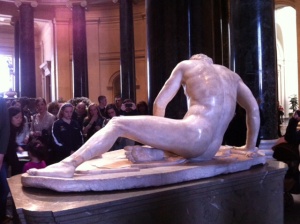It’s a bad day for artistic creativity and expression.
A jury has found Pharrell Williams and Robin Thicke guilty of plagiarizing Marvin Gaye’s “Got to Give it Up” in their song “Blurred Lines.” I find this not only appalling, but frightening as well. Copyright is important, let’s not have any confusion about that, but what I would argue is even more important is creativity.
An artwork of any medium (musical, lyrical, visual, written, etc) is utterly interdependent on other artwork. If we take even the briefest of looks at history, it doesn’t take long to figure out that artistic movements occur in reaction to each other. One poetic movement grows out of a previous one, another poetic movement arises as a response to and a reaction against that previous one. The same is true for music and sculpture and visual art.

So for the sake of argument, let’s say there is some similarity between these two songs; whether you want to say that similarity is a bass line, the beat, a mood/tone, whatever, is up to you. Is “Blurred Lines” so similar to “Got to Give it Up” that it should be accused of plagiarism rather than simply artistic inspiration? And it’s not about the money that Williams and Thicke will have to pay up for this supposed infringement; it’s about the bloody principle of the thing. What is the line between inspiration and infringement? Or between sharing and stealing creativity? Of course sometimes people outright steal creative works from other people, and that is beyond terrible. But I think what happens far more– and what should be allowed to continue to happen– is that artists are inspired by other artists. They “take something [they] love and build on it.” That quote is from a TED Radio Hour excerpt, which you can listen to here:
http://www.npr.org/2014/06/27/322721353/why-would-more-than-500-artists-sample-the-same-song
This is the short version of the TED Radio Hour with Mark Ronson, on “What is Original?” and is pretty much all the proof you need. To put it briefly, Ronson explains how Slick Rick and Doug E. Fresh’s “La Di Da Di” is a foundational song, from which a number of artists took inspiration, including: Beastie Boys, Miley Cyrus, Snoop Dogg, The Notorious B.I.G., Beyoncé, Kanye West, and plenty of others. In other words, to quote Picasso, “Good artists copy, great artists steal.”

Velazquez’s Las Meninas

And a Picasso version of Las Meninas, inspired by Velazquez’s work
There are no original ideas. I feel like that’s a pretty well-established fact. There are unique spins, new combinations, etc, but no one’s going to reinvent the wheel. The wheel exists, and we just put our own spins on it (see what I did there?). So when you have a musician like Taylor Swift try to copyright some phrases from her lyrics including “this sick beat” and “party like it’s 1989,” we run into a real problem.

Manet’s Olympia….

…. Inspired by Titian’s Venus of Urbino
There are many great things about the primacy of the individual in our society. This court finding, however, is an example of its dark side. We are so concerned with our individual thoughts and ideas and work that first off, we fail to acknowledge how dependent we are on the artists and thinkers who came before us, and how we couldn’t have come up with any of the thoughts and creative works that we have without those who paved the way, and they could not have come up with anything without the work of those generations before them, and so on and on. And secondly, we fail to share in the community of creativity where others can inspire us, and where we can inspire others to pass on this deeply human drive and desire to create.




